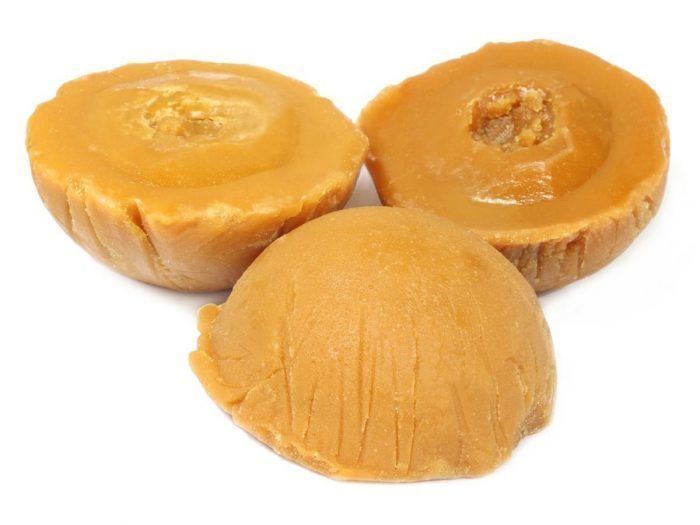 | ||
Similar Ghee, Dal, Laddu, Kheer, Cardamom | ||
Traditional jaggery making making of gurr village food factory
Jaggery is a traditional non-centrifugal cane sugar consumed in Asia, Africa and some countries in the Americas. It is a concentrated product of date, cane juice, or palm sap (see palm sugar) without separation of the molasses and crystals, and can vary from golden brown to dark brown in colour. It contains up to 50% sucrose, up to 20% invert sugars, and up to 20% moisture, with the remainder made up of other insoluble matter, such as wood ash, proteins, and bagasse fibres. Jaggery is mixed with other ingredients, such as peanuts, condensed milk, coconut, and white sugar, to produce several locally marketed and consumed delicacies.
Contents
- Traditional jaggery making making of gurr village food factory
- health and beauty benefits of jaggery gurh ms pinky madaan
- Origins and production
- Preparation of jaggery
- South Asia
- Other uses
- In South Asia
- Myanmar Burma
- Malaysia
- Indonesia
- Philippines
- Thailand
- Elsewhere
- References
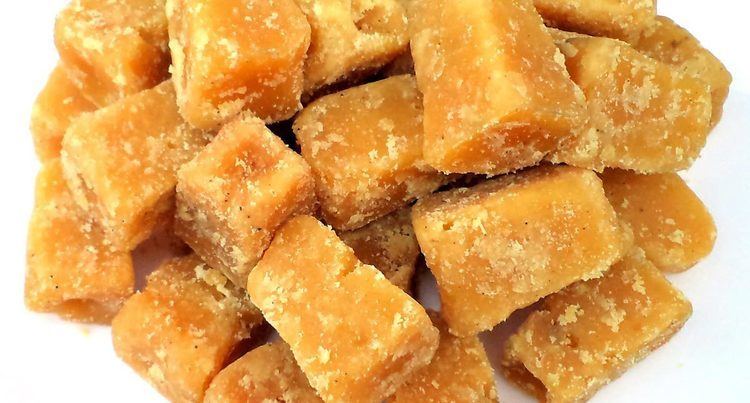
Unrefined, it is known by various names, including panela, in other parts of the world.
health and beauty benefits of jaggery gurh ms pinky madaan
Origins and production
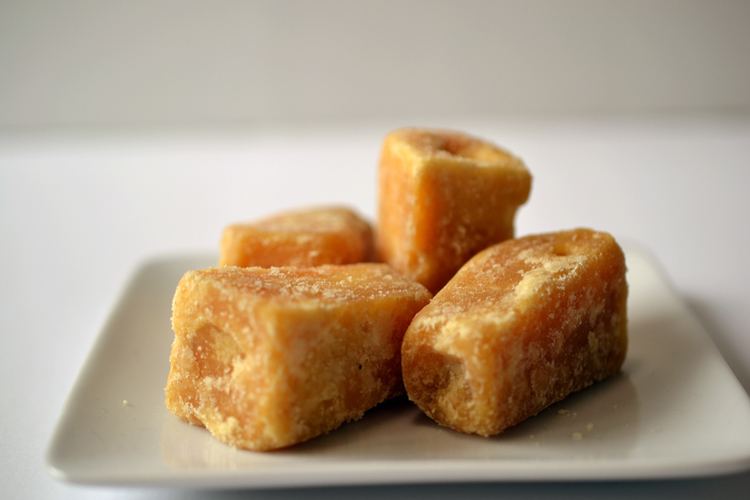
Jaggery is made of the products of sugarcane and the date palm tree. The sugar made from the sap of the date palm is both more prized and less commonly available outside of the regions where it is made. The date palm is tapped for producing jaggery in West Bengal, South India, Bangladesh, Pakistan, Nepal and Sri Lanka. In Sri Lanka, syrup extracts from kithul (Caryota urens) trees are widely used for jaggery production. This is considered the best jaggery available on the local market and is more highly valued than that from other sources.
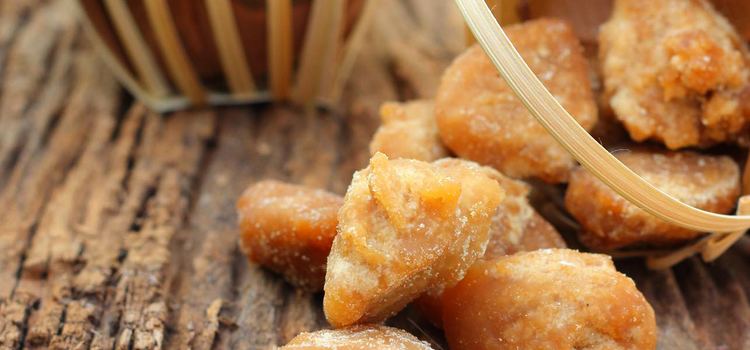
All types of the sugar come in blocks or pastes of solidified concentrated sugar syrup heated to 200 °C (392 °F). Traditionally, the syrup is made by boiling raw sugarcane juice or palm sap in large, shallow, round-bottom vessels.
Preparation of jaggery

Historically, the sugar cane cultivators used crushers which were ox-driven. Nowadays all the crushers are power-driven. These crushers are located in fields near the sugar crop. The cut and cleaned sugar cane is put into the crusher. The extracted sugar cane juice is collected in a big vessel. A certain quantity of the juice is transferred to a smaller vessel for heating on a furnace.
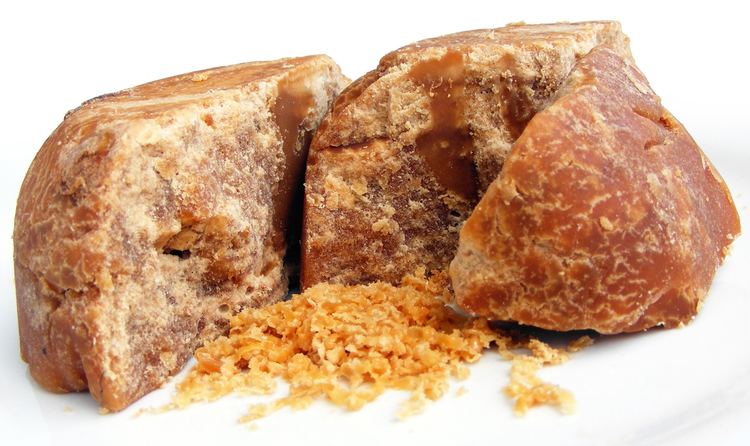
The vessel is heated for about one hour. Dried wood pulp from the crushed sugar cane is used as fuel for the furnace. While boiling the juice, some lime is added to it so that all the wood particles are collected on top of the juice in a froth during boiling which is skimmed off. Finally the juice is thickened and reduced to nearly one- third of the original volume. This hot liquid is golden in color. It is stirred continuously and lifted with a spatula to observe whether it forms a thread or drips dropwise while falling. If it forms many threads, it has completely thickened. Now it is poured into a shallow flat bottomed concrete tank to cool and solidify. The tank is large enough to allow only a thin coat of this hot liquid to form at its bottom, so as to increase the surface area for quick evaporation and cooling. After cooling down the jaggery becomes a soft solid which is now pressed into the desired shape for selling at the market.

The quality of the jaggery is judged by its color; brown means it is higher in impurities and golden-yellow implies it is relatively pure. Due to this grading scale there are malpractices of adding color or harmful chemicals to simulate the golden color.
South Asia
Jaggery, also called gurh, is used as an ingredient in sweet and savoury dishes across India, Pakistan, Bangladesh, Nepal, Sri Lanka as well as in Afghanistan and Iran. For example, a pinch of it is sometimes added to sambar, rasam, and other staples. Jaggery is added to lentil soups (dāl) to add sweetness to balance the spicy, salty and sour components, particularly in Gujarati cuisine.
Maharashtra is the largest producer and consumer of jaggery (gud (गुड़) in Hindi, "gul" (गुळ) in Marathi); and (گڑھ) in Urdu most vegetable dishes, curries, and dals and many desserts contain it. This is specially used during Makar Sankranti for making a dessert called tilgul. In Gujarat, known as gôḷ (ગોળ), during Makara Sankranti, a similar preparation called tal na ladu or tal sankli is made. In rural Maharashtra and Karnataka, water and a piece of jaggery is given when someone arrives home from working under a hot sun.
Molasses (काकवी), a byproduct of the production of jaggery, is used in rural Maharashtra and Karnataka as a sweetener. It contains many minerals not found in ordinary sugar and is considered beneficial to health in traditional Ayurvedic medicine. It is an ingredient of many sweet delicacies, such as gur ke chawal /Chol ("jaggery rice"), a traditional Rajasthani or Punjabi dish.
In Gujarat, laddus are made from wheat flour and jaggery. A well-known Maharashtrian recipe, puran poli, uses it as a sweetener apart from sugar. Jaggery is considered an easily available sweet which is shared on any good occasion. In engagement ceremonies, small particles of it are mixed with coriander seeds (ધાણા). Hence in many Gujarati communities, engagement is commonly known as gol-dhana (ગોળ-ધાણા), literally "jaggery and coriander seeds".
In Sri Lanka, jaggery is made using the treacle of the kithul tree.
Jaggery is used extensively in South India to balance the heat of the spicy foods. It is also known to stir heat on the body, which causes sweating, a way for the body to cool down in the high summer heat.
In Andhra Pradesh, it is used for sweets like Chakkara pongal, milk pongal (prepared with rice, milk, jaggery). During Sankranthi they prepare 'Arisalu' which is an authentic Andhra Pradesh dish. In Kerala, it is considered auspicious and is widely used in cooking. It is a vital ingredient in many varieties of payasam, a sweet dish.
In Tamil Nadu, jaggery used exclusively as the sweetener. It is used in a dish called chakkarai pongal. It is prepared during the festival of Pongal (Thai Pongal), which is held when the harvesting season begins. It is also used to make kalhi, to sweeten fruit salads and payasam (sweet milk) that are offered to the Gods. Jaggery is also used in religious rituals. In rural areas, cane jaggery and palm Jaggery are still used to sweeten beverages, whereas refined sugar has replaced it in urban areas.
In Oriya cuisine, cakes or piṭhas contain jaggery. Some marmalades made of mango and Dillenia contain the ingredient.
In Bengali Hindu cuisine, it is commonly used in making sweet dishes, some of which mix jaggery with milk and coconut. Popular sweet dishes such as laḍḍu/laṛu or paṭishapta piṭha mix it with coconut shreds. Jaggery is molded into novel shapes as a type of candy. The same preparation of sweets have been made in its neighbouring state of Assam. Some of the popular sweet dishes of Assam. such as til-pitha (made of rice powder, sesame and jaggery), other rice-based pitha, and payas are made of jaggery. In some villages of Assam, people drink salty red tea with a cube of gurd (jaggery), which is popularly called cheleka-chah (licking tea).
Traditional Karnataka sweets, such as paayasa, obbattu (holige) and unday use different kinds of jaggery. A pinch is commonly added to sambar (a.k.a. huLi saaru) and rasam (a.k.a. saaru). Karnataka produces sugar and palm-based jaggery. The combination of crushed jaggery with ghee is excellent and goes well with chapathi.
The Muzaffarnagar District in Uttar Pradesh has the largest jaggery market in the world, followed by Anakapalli in the Visakhapatnam District in Andhra Pradesh. The Kolhapur District in western Maharashtra is famous for its variety of jaggery, which is yellow and much sought-after in Maharashtra and Gujarat. Mandya in Karnataka is known for its jaggery production.
All over India, jaggery has religious significance to Hindus. Many of the festivals involve the offering of jaggery to deities during worship. Jaggery is considered auspicious in many parts of India and is eaten raw before the commencement of good work or any important new venture, or after good news is shared by family and friends.
In Myanmar, jaggery is harvested from toddy palm syrup. In central Myanmar and around Bagan (Pagan), toddy syrup is collected solely for making jaggery. The translucent white syrup is boiled until it becomes golden brown and then made into bite-sized pieces. It is considered a sweet and is eaten by children and adults alike, usually in the afternoon with a pot of green tea. It has been referred to locally as Burmese chocolate. Toddy palm jaggery is sometimes mixed with coconut shreds, jujube puree or sesame, depending on the area. This type of jaggery is also used in Burmese cooking, usually to add colour and enrich the food.
Other uses
Other uses include jaggery toffees and jaggery cake made with pumpkin preserve, cashew nuts, peanuts and spices.
Jaggery may be used in the creation of alcoholic beverages such as palm wine.
Besides being a food, jaggery may be used, mixed in an emulsion with buttermilk and mustard oil, to season the inside of tandoor ovens. Jaggery is also used in natural dying of fabric. Also used in hookah in the rural areas of Pakistan and India.
